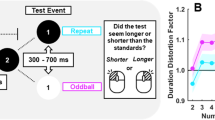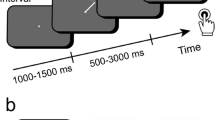Abstract
Our experience of time is strikingly plastic: Depending on contextual factors, the same objective duration can seem to fly by or drag on. Perhaps the most direct demonstration of such subjective time dilation is the oddball effect: when seeing identical objects appear one after another, followed by an “oddball” (e.g., a disc that suddenly grows in size, in a sequence of otherwise static discs), observers experience this oddball as having lasted longer than its nonoddball counterparts. Despite extensive work on this phenomenon, a surprisingly foundational question remains unasked: What actually gets dilated? Beyond the oddball, are the objects just before (or just after) the oddball also dilated? As in previous studies, observers viewed sequences of colored discs, one of which could be the oddball—and subsequently reproduced the oddball’s duration. Unlike previous studies, however, there were also critical trials in which observers instead reproduced the duration of the disc immediately before or after the oddball. A clear pattern emerged: oddball-induced time dilation extended to the post-oddball disc, but not the pre-oddball disc. Whence this temporal asymmetry? We suggest that an oddball’s sudden appearance may induce uncertainty about what will happen next, heightening attention until after the uncertainty is resolved.


Similar content being viewed by others
Data availability
All data generated or analyzed during this study are included in this published article (and its Supplementary Information files).
Notes
Dividing corresponding Oddball and No-Oddball trials in this way effectively isolates that difference in reproduction that is due solely to the Oddball (since the corresponding trials share identical timings and reproduced disc position). This therefore factors out alternative potential influences that could affect attention (besides the Oddball being present), such as the “foreperiod” or “hazard” effect (wherein attention may gradually heighten as the sequence progresses before an oddball appears; e.g., Wehrman et al., 2020).
References
Birngruber, T., Schröter, H., & Ulrich, R. (2014a). Duration perception of visual and auditory oddball stimuli: Does judgment task modulate the temporal oddball effect? Attention, Perception, & Psychophysics, 76, 814–828.
Birngruber, T., Schröter, H., & Ulrich, R. (2014b). What makes an oddball odd? Evidence from a spatially predictable temporal oddball paradigm. Procedia—Social and Behavioral Sciences, 126, 190–191.
Birngruber, T., Schröter, H., & Ulrich, R. (2015). Introducing a control condition in the classic oddball paradigm: Oddballs are overestimated in duration not only because of their oddness. Attention, Perception, & Psychophysics, 77, 1737–1749.
Block, R. A. (1978). Remembered duration: Effects of event and sequence complexity. Memory & Cognition, 6, 320–326.
Block, R. A., & Gruber, R. P. (2014). Time perception, attention, and memory: A selective review. Acta Psychologica, 149, 129–133.
Cai, M. B., Eagleman, D. M., & Ma, W. J. (2015). Perceived duration is reduced by repetition but not by high-level expectation. Journal of Vision, 15(19), 1–7.
Carrasco, M., & Barbot, A. (2019). Spatial attention alters visual appearance. Current Opinion in Psychology, 29, 56–64.
Correa, Á., Sanabria, D., Spence, C., Tudela, P., & Lupiáñez, J. (2006). Selective temporal attention enhances the temporal resolution of visual perception: Evidence from a temporal order judgment task. Brain Research, 1070, 202–205.
de Leeuw, J. R., Gilbert, R. A., Petrov, N., & Luchterhandt, B. (2023). Simulating behavior to help researchers build experiments. Behavior Research Methods, 55, 1863–1873.
Eagleman, D. M. (2008). Human time perception and its illusions. Current Opinion in Neurobiology, 18, 131–136.
Eagleman, D. M., & Pariyadath, V. (2009). Is subjective duration a signature of coding efficiency? Philosophical Transactions of the Royal Society B: Biological Sciences, 364, 1841–1851.
Egeth, H. E., & Yantis, S. (1997). Visual attention: Control, representation, and time course. Annual Review of Psychology, 48, 269–297.
Grondin, S. (2010). Timing and time perception: A review of recent behavioral and neuroscience findings and theoretical directions. Attention, Perception, & Psychophysics, 72, 561–582.
Liverence, B. M., & Scholl, B. J. (2012). Discrete events as units of perceived time. Journal of Experimental Psychology: Human Perception and Performance, 38, 549–554.
Macar, F., Grondin, S., & Casini, L. (1994). Controlled attention sharing influences time estimation. Memory & Cognition, 22, 673–686.
Mathys, C. (2011). A Bayesian foundation for individual learning under uncertainty. Frontiers in Human Neuroscience, 5, 1–20.
Mathys, C. D., Lomakina, E. I., Daunizeau, J., Iglesias, S., Brodersen, K. H., Friston, K. J., & Stephan, K. E. (2014). Uncertainty in perception and the hierarchical Gaussian filter. Frontiers in Human Neuroscience, 8, 1–24.
Matthews, W. J. (2011). Stimulus repetition and the perception of time: The effects of prior exposure on temporal discrimination, judgment, and production. PLOS ONE, 6, Article e19815.
Matthews, W. J., & Meck, W. H. (2014). Time perception: The bad news and the good: Time perception. Wiley Interdisciplinary Reviews: Cognitive Science, 5, 429–446.
Matthews, W. J., & Meck, W. H. (2016). Temporal cognition: Connecting subjective time to perception, attention, and memory. Psychological Bulletin, 142, 865–907.
Matthews, W. J., Terhune, D. B., van Rijn, H., Eagleman, D. M., Sommer, M. A., & Meck, W. H. (2014). Subjective duration as a signature of coding efficiency: Emerging links among stimulus repetition, predictive coding, and cortical GABA levels. Timing & Time Perception Reviews, 1, 1–12.
McAuley, J. D., & Fromboluti, E. K. (2014). Attentional entrainment and perceived event duration. Philosophical Transactions of the Royal Society b: Biological Sciences, 369, 20130401.
Montagna, B., & Carrasco, M. (2006). Transient covert attention and the perceived rate of flicker. Journal of Vision, 6, 955–965.
New, J. J., & Scholl, B. J. (2009). Subjective time dilation: Spatially local, object-based, or a global visual experience? Journal of Vision, 9, 1–11.
Noyes, R., Jr., & Kletti, R. (1976). Depersonalization in the face of life-threatening danger: A description. Psychiatry, 39, 19–27.
Palan, S., & Schitter, C. (2018). Prolific.ac—A subject pool for online experiments. Journal of Behavioral & Experimental Finance, 17, 22–27.
Pariyadath, V., & Eagleman, D. (2007). The effect of predictability on subjective duration. PLOS ONE, 2, Article e1264.
Pariyadath, V., & Eagleman, D. M. (2008). Brief subjective durations contract with repetition. Journal of Vision, 8(11), 1–6.
Phillips, I. (2013). Perceiving the passing of rime. Proceedings of the Aristotelian Society, 113, 225–252.
Schindel, R., Rowlands, J., & Arnold, D. H. (2011). The oddball effect: Perceived duration and predictive coding. Journal of Vision, 11(17), 1–9.
Tse, P. (2010). Attention underlies subjective temporal expansion. In A. C. Nobre & J. T. Coull (Eds.) Attention and Time (pp. 137–150). Oxford University Press.
Tse, P. U., Intriligator, J., Rivest, J., & Cavanagh, P. (2004). Attention and the subjective expansion of time. Perception & Psychophysics, 66, 1171–1189.
Ulrich, R., & Bausenhart, K. M. (2019). The temporal oddball effect and related phenomena: Cognitive mechanisms and experimental approaches. In V. Arstila, A. Bardon, S. E. Power, & A. Vatakis (Eds.), The illusions of time: Philosophical and psychological essays on timing and time perception (pp. 71–89). Palgrave Macmillan.
van Wassenhove, V., Buonomano, D. V., Shimojo, S., & Shams, L. (2008). Distortions of subjective time perception within and across senses. PLOS ONE, 3, Article e1437.
Wearden, J. (2016). The psychology of time perception. Springer.
Wehrman, J. J., Wearden, J., & Sowman, P. (2020). The expected oddball: Effects of implicit and explicit positional expectation on duration perception. Psychological Research Psychologische Forschung, 84, 713–727.
Wutz, A., Shukla, A., Bapi, R. S., & Melcher, D. (2015). Expansion and compression of time correlate with information processing in an enumeration task. PLOS ONE, 10, Article e0135794.
Acknowledgements
This project was funded by ONR MURI #N00014-16-1-2007 awarded to B.J.S. For helpful inspiration, conversations, and comments, we thank Aditya Upadhyayula, Ian Phillips, Jonathan Flombaum, and the members of the Yale Perception and Cognition Laboratory.
Open practices
The preregistered methods and analyses for both experiments can be viewed at: https://aspredicted.org/blind.php?x=7ga89t (Experiment 1) and https://aspredicted.org/blind.php?x=gk22wi (Experiment 2).
Author information
Authors and Affiliations
Contributions
J.D.K.O., K.W.W., and B.J.S. designed the research and wrote the manuscript. J.D.K.O. conducted the experiments and analyzed the data with input from K.W.W. and B.J.S.
Corresponding authors
Ethics declarations
Competing interests
The authors declare no competing interests.
Additional information
Publisher's Note
Springer Nature remains neutral with regard to jurisdictional claims in published maps and institutional affiliations.
Supplementary Information
Below is the link to the electronic supplementary material.
Rights and permissions
Springer Nature or its licensor (e.g. a society or other partner) holds exclusive rights to this article under a publishing agreement with the author(s) or other rightsholder(s); author self-archiving of the accepted manuscript version of this article is solely governed by the terms of such publishing agreement and applicable law.
About this article
Cite this article
Ongchoco, J.D.K., Wong, K.W. & Scholl, B.J. What’s next?: Time is subjectively dilated not only for ‘oddball’ events, but also for events immediately after oddballs. Atten Percept Psychophys 86, 16–21 (2024). https://doi.org/10.3758/s13414-023-02800-7
Accepted:
Published:
Issue Date:
DOI: https://doi.org/10.3758/s13414-023-02800-7




